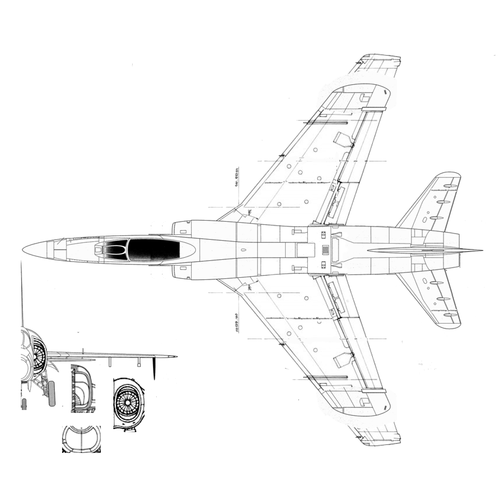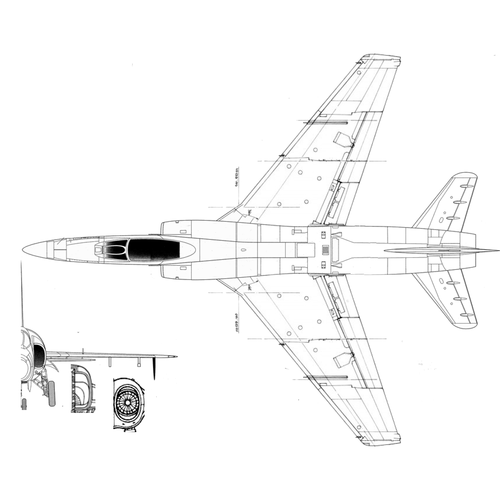Hi all! Edited to neaten up some things.
Simple POD: Some bright engineer at Grumman notices that aircraft designed to fit two abreast in a 58 foot wide hangar won't fit 2 abreast in their allies 52 wide hangars. Management concurs and also observes that having more than one customer is good for business. Thus they alter the design in order to make fitting a wing fold easier.
I am going to blatantly and shamelessly rip off the wing of the FJ-4 for this exercise. Let the alternate universe lawyers sue if they wish, one is dihedral and the other is anhedral should be enough to keep them at bay.. lol.
The basic design can be fitted with either the traditional short or extended wingtips that flip upwards. The short tip has a wing area of 310 square feet at a span of 33.33 feet and the extended 340 at a span of 39.375 feet, in either case the wing carries 200 gallons of fuel per side for 208 gallons more than the historic Tiger unless it is fitted with the folding wing in which case it carries as much fuel in the inner panels as the historic Tiger.
The fold point on the wing is the dark line at the break between the flaps and flaperons and includes the tips of the tail folding down, giving a folded span of 13.5 feet. The flip tips, 27.75 feet. Tigers in USN service used the short tips, the increase in wing area over the historic Tiger reduces the launch/landing speed by 10%; if fitted with the extended tips 15%. The historic Tiger had a power on stall speed of about 105 MPH and a safe approach airspeed of 138 MPH so that translates to a power on stall of 94.5 short, 89.25 extended with a safe approach speed of 127.5 and 122.25 MPH respectively. If fitted with BLC and using the figures from Grumman installations of it on Cougars we can reduce this by a further 17 MPH, this will also give the equivalent of 7 MPH of WOD at launch. However fitting BLC with the J-65 would IMHO be quasi suicidal, but something to keep in mind for a better power plant.
With essentially 20% more fuel over the historic Tiger this one has about 20% better range and endurance.. except the folded wing version which would have exactly the same as the historic. EDIT: This comes out to about the range of the J79 Super Tiger with the historic fuel load... good lord the J65 must have been a pig!
Question.. if Grumman demonstrated this starting in 1955 to overseas buyers can you think of anyone that might show an interest?
Simple POD: Some bright engineer at Grumman notices that aircraft designed to fit two abreast in a 58 foot wide hangar won't fit 2 abreast in their allies 52 wide hangars. Management concurs and also observes that having more than one customer is good for business. Thus they alter the design in order to make fitting a wing fold easier.
I am going to blatantly and shamelessly rip off the wing of the FJ-4 for this exercise. Let the alternate universe lawyers sue if they wish, one is dihedral and the other is anhedral should be enough to keep them at bay.. lol.
The basic design can be fitted with either the traditional short or extended wingtips that flip upwards. The short tip has a wing area of 310 square feet at a span of 33.33 feet and the extended 340 at a span of 39.375 feet, in either case the wing carries 200 gallons of fuel per side for 208 gallons more than the historic Tiger unless it is fitted with the folding wing in which case it carries as much fuel in the inner panels as the historic Tiger.
The fold point on the wing is the dark line at the break between the flaps and flaperons and includes the tips of the tail folding down, giving a folded span of 13.5 feet. The flip tips, 27.75 feet. Tigers in USN service used the short tips, the increase in wing area over the historic Tiger reduces the launch/landing speed by 10%; if fitted with the extended tips 15%. The historic Tiger had a power on stall speed of about 105 MPH and a safe approach airspeed of 138 MPH so that translates to a power on stall of 94.5 short, 89.25 extended with a safe approach speed of 127.5 and 122.25 MPH respectively. If fitted with BLC and using the figures from Grumman installations of it on Cougars we can reduce this by a further 17 MPH, this will also give the equivalent of 7 MPH of WOD at launch. However fitting BLC with the J-65 would IMHO be quasi suicidal, but something to keep in mind for a better power plant.
With essentially 20% more fuel over the historic Tiger this one has about 20% better range and endurance.. except the folded wing version which would have exactly the same as the historic. EDIT: This comes out to about the range of the J79 Super Tiger with the historic fuel load... good lord the J65 must have been a pig!
Question.. if Grumman demonstrated this starting in 1955 to overseas buyers can you think of anyone that might show an interest?
Attachments
Last edited:



